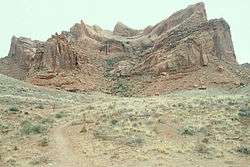Syncline
.png)
In structural geology, a syncline is a fold with younger layers closer to the center of the structure. A synclinorium (plural synclinoriums or synclinoria) is a large syncline with superimposed smaller folds.[1] Synclines are typically a downward fold, termed a synformal syncline (i.e. a trough); but synclines that point upwards, or perched, can be found when strata have been overturned and folded (an antiformal syncline).
Characteristics
On a geologic map, synclines are recognized by a sequence of rock layers that grow progressively younger, followed by the youngest layer at the fold's center or hinge, and by a reverse sequence of the same rock layers on the opposite side of the hinge. If the fold pattern is circular or elongate circular the structure is a basin. Folds typically form during crustal deformation as the result of compression that accompanies orogenic mountain building.
Notable examples
- Powder River Basin, Wyoming, U.S.A.
- Sideling Hill roadcut along Interstate 68 in western Maryland, USA, where the Rockwell Formation and overlying Purslane Sandstone are exposed.
- Western Lake Superior, which occupies a basin created by the Midcontinent Rift System
- Saou, a commune in the Drôme department in southeastern France
- The Catlins, an area in the southeastern corner of the South Island of New Zealand
Gallery
-

Syncline exposed in Sideling Hill roadcut
-

Snow-dusted syncline in Provo Canyon, Utah.
-
Road cut near Fort Davis, Texas showing a syncline.
-
Rainbow Basin Syncline in the Barstow Formation near Barstow, California.
-
Syncline in the lower parking lot of Calico Ghost Town; note ductile folding at base, brittle above.
-

Synclinal fold in Silurian Wills Creek Formation or Bloomsburg Formation at Roundtop Hill (Maryland)
-

East wall of Bear Valley Strip Mine, near Shamokin, Pennsylvania
-

Syncline in Navajo Sandstone, Upheaval Dome, Canyonlands National Park, Utah.
See also
- Anticline
- Homocline
- Monocline
- Ridge-and-valley Appalachians — With good bird's eye photo of a range of the types
References
- ↑ Synclinorium. (2008). In Encyclopædia Britannica. Retrieved May 03, 2008, from Encyclopædia Britannica Online: http://www.britannica.com/EBchecked/topic/578375/synclinorium